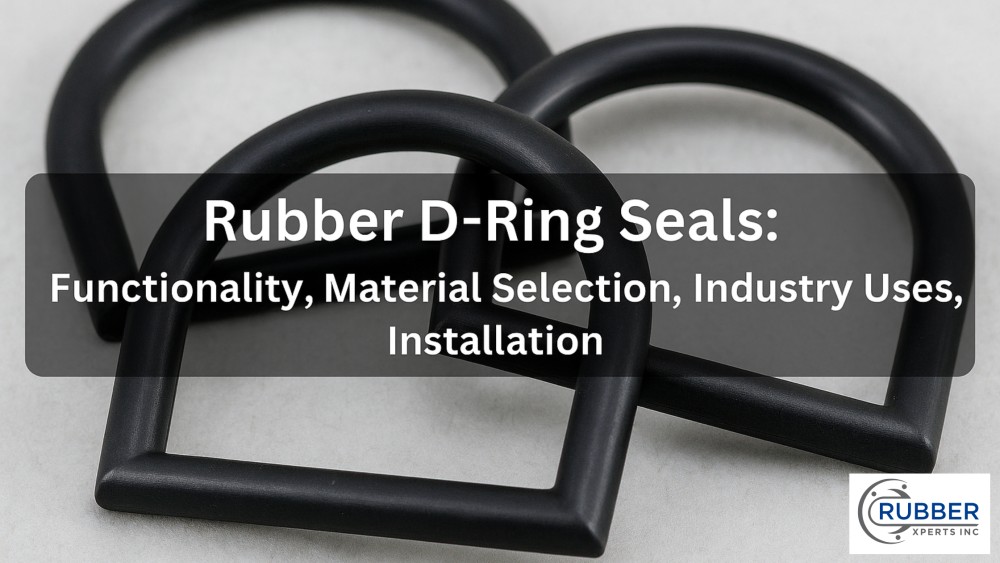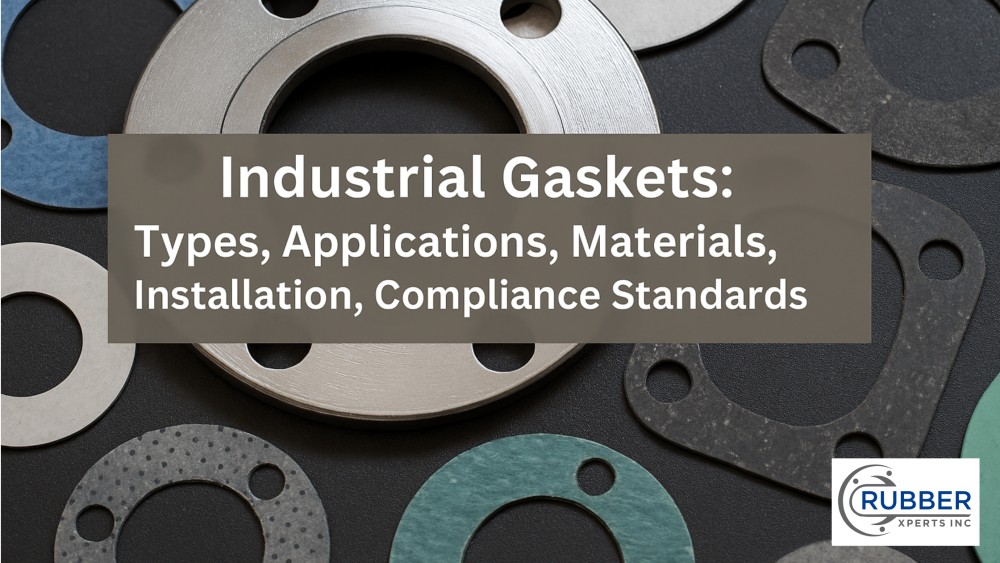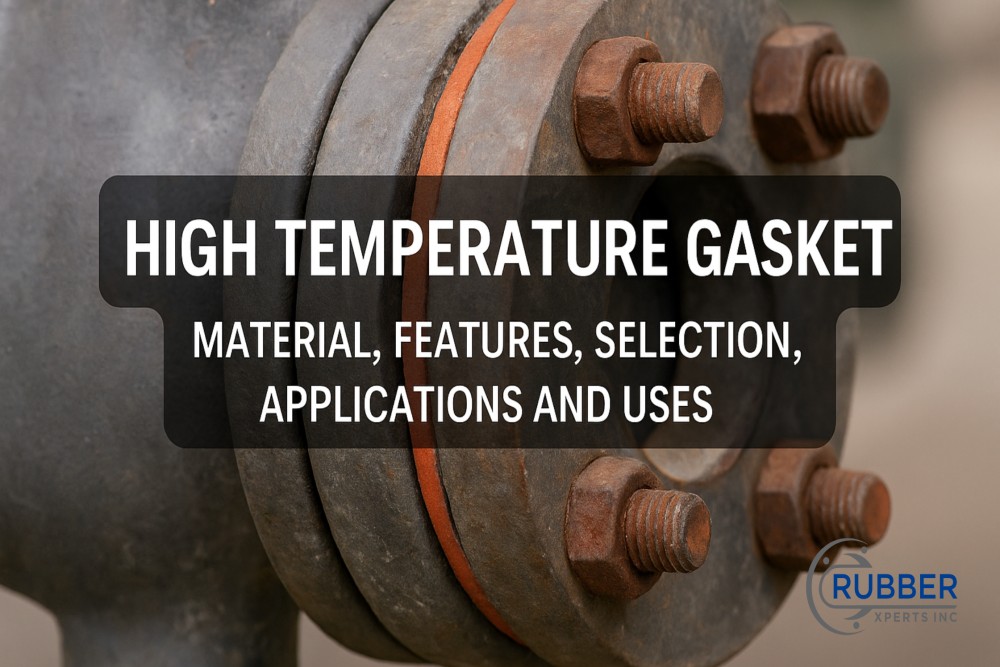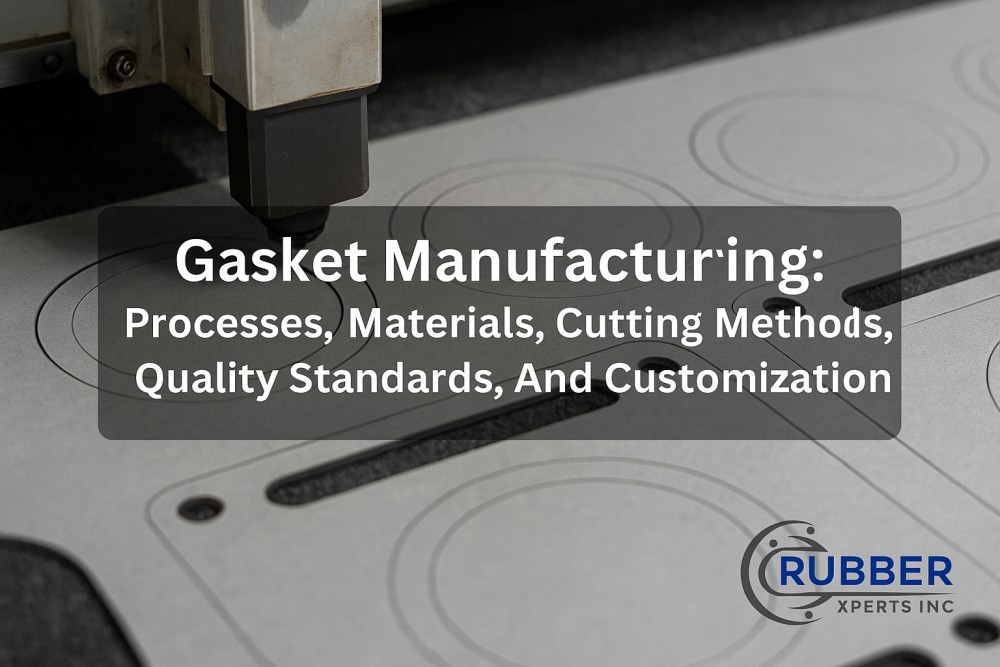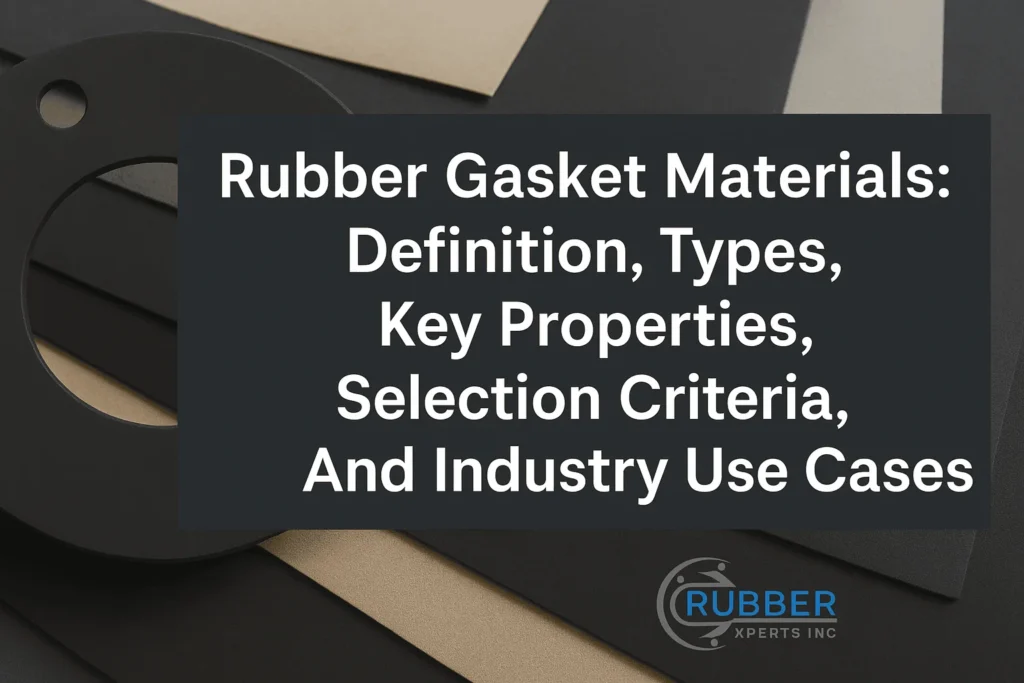Rubber elasticity is the ability of elastomeric materials to undergo deformation under stress and return to their original shape once the force is removed. This unique polymer behavior results from the molecular structure of rubber compounds, which allows for flexibility, durability, and efficient mechanical response.
The factors of rubber elasticity include molecular weight, crosslink density, polymer composition, and vulcanization. These elements influence the viscoelastic properties of rubber, determining its stretchability, stress-strain relationship, and overall elastomer performance in different industrial applications.
The measurement of rubber elasticity is conducted through tensile testing, dynamic mechanical analysis, and compression tests. These methods evaluate deformation resistance, stress-strain response, and mechanical stability to ensure optimal material performance in industrial usage.
Applications of rubber elasticity are in industries such as automotive, aerospace, medical, and construction. Its ability to absorb mechanical stress, provide sealing efficiency, and withstand environmental factors makes it indispensable in gaskets, seals, and vibration dampers.
The benefits of rubber elasticity include enhanced flexibility, durability, impact resistance, and energy efficiency. These characteristics ensure the longevity and reliability of elastomeric products, making them suitable for demanding environments where mechanical resilience is required.
What is Rubber Elasticity?
Rubber elasticity is the ability of rubber-like materials to stretch under stress and return to their original shape once the force is removed. This elastomeric behavior is due to the polymeric structure of rubber, which allows for significant molecular flexibility and strain recovery. The elasticity modulus and tensile properties define how well rubber withstands deformation mechanics while maintaining durability and resilience.
In industrial sealing applications, elastic rubbers are important in ensuring tight, reliable seals that adapt to pressure changes and mechanical stresses. Their ability to absorb energy and recover from deformation makes them ideal for creating gaskets, O-rings, and other sealing components in dynamic environments.
The key characteristics that make rubber elasticity necessary for sealing include high strain recovery, excellent tensile properties, and resistance to permanent deformation. Flexible polymers enable seals to maintain their integrity under varying temperatures, pressures, and chemical exposures, ensuring long-lasting performance in necessary applications.
What Are the Factors of Rubber Elasticity?
The factors of rubber elasticity are the type of polymer, number of crosslinks, molecular weight, temperature effects, vulcanization, and plasticizer content. These elements collectively determine the strain recovery, tensile behavior, and overall flexibility of rubber materials. The interplay between polymer composition, crosslink density, and environmental conditions influences how elastomers perform under stress, ensuring durability and resilience in industrial applications.
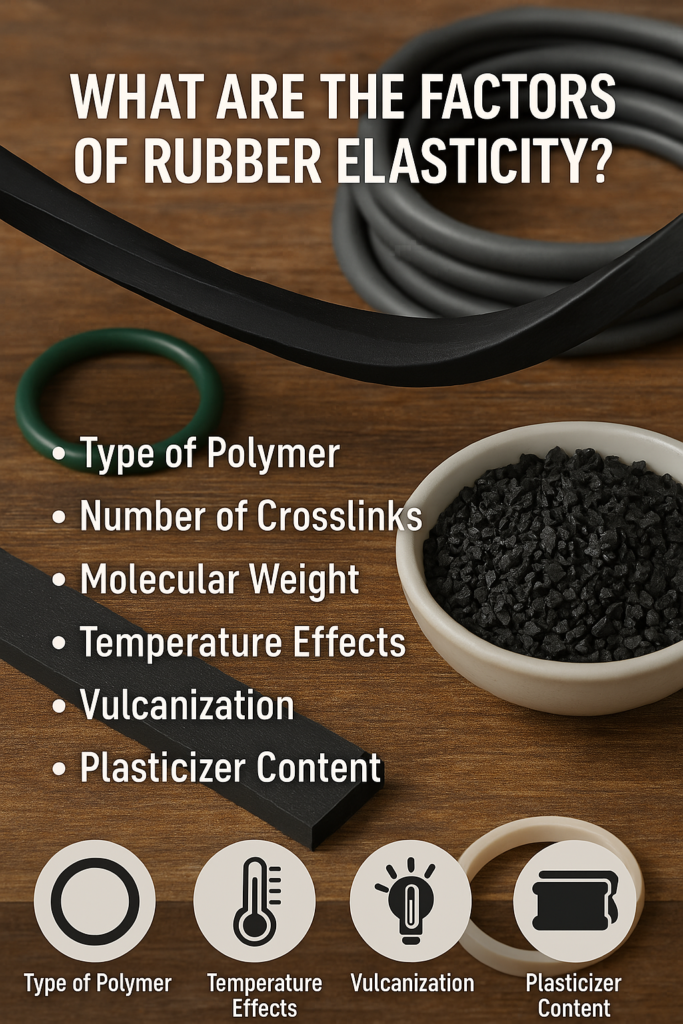
The factors of rubber elasticity are as follows:
Type of Polymer
The type of polymer used in a rubber compound significantly impacts its elasticity. Natural and synthetic rubbers differ in molecular structure, influencing strain recovery and tensile properties. Polymers with higher molecular flexibility exhibit superior elastomeric behavior, allowing them to stretch and return to their original shape effectively. Polymer composition determines the extent to which rubber withstands environmental influences such as heat and chemical exposure, setting the foundation for its mechanical performance.
Number of Crosslinks
Crosslink density, or the number of crosslinks formed between polymer chains, is an integral factor in rubber elasticity. A higher number of crosslinks enhances strength and resistance to permanent deformation but reduces flexibility. Conversely, lower crosslink density increases molecular movement, improving elasticity but decreasing durability. This balance between elasticity and mechanical strength is carefully controlled during rubber formulation to meet specific industrial requirements. The number of crosslinks directly influences molecular weight, further dictating elasticity behavior.
Molecular Weight
Molecular weight refers to the length and mass of polymer chains, playing an important role in determining the elasticity of rubber. Higher molecular weight polymers exhibit better strain recovery and tensile properties due to increased chain entanglements. These entanglements improve deformation mechanics, ensuring that rubber stretches under stress and returns to its original shape. Molecular weight also affects crystallinity levels, impacting how rubber responds to external forces and environmental conditions.
Temperature Effects
Temperature profoundly impacts rubber elasticity due to its influence on polymer mobility. At lower temperatures, elastomers become stiffer as molecular motion decreases, leading to reduced elasticity and increased brittleness. Polymers become more flexible at higher temperatures, enhancing strain recovery but potentially weakening mechanical strength. The temperature effects on rubber elasticity are significant for applications requiring consistent performance across various thermal conditions, directly influencing the effectiveness of vulcanization.
Vulcanization
Vulcanization is the process of introducing crosslinks, typically through sulfur curing, to improve the durability and elasticity of rubber. This process enhances the material’s ability to absorb energy and recover from deformation, making it ideal for high-performance applications. The vulcanization impact is closely tied to crosslink density and molecular weight, ensuring optimal tensile properties and long-term resilience. The effectiveness of vulcanization is modified by altering plasticizer content, which further refines the elasticity and flexibility of rubber compounds.
Plasticizer Content
Plasticizers are additives used to modify the flexibility and elasticity of rubber compounds. Plasticizers increase molecular mobility, enhancing strain recovery and making rubber more pliable by reducing intermolecular forces. However, excessive plasticizer content weakens crosslink density, compromising tensile strength and durability. The balance between plasticizer content and crosslinking determines the final mechanical properties of rubber, ensuring that it meets specific industrial and environmental demands.
What are the Measurement Methods of Rubber Elasticity?
The measurement methods of rubber elasticity are tensile testing, viscoelastic testing, compression test method, and dynamic mechanical analysis (DMA)
.

These methods help determine the stress-strain behavior, elongation at break, fatigue resistance, and overall mechanical performance of rubber materials. Manufacturers optimize rubber formulations to meet specific industrial requirements by analyzing these properties.
Tensile Testing
Tensile testing is a fundamental method used to measure the elasticity and strength of rubber materials. This test involves stretching a rubber sample until it breaks while recording key properties such as tensile strength, elongation at break, and modulus determination. The stress-strain analysis obtained from tensile testing provides necessary insights into how a rubber compound will perform under mechanical stress. This method is important for evaluating the durability and resilience of elastomers used in high-stress applications such as automotive seals and industrial gaskets.
Viscoelastic Testing
Viscoelastic testing evaluates both the elastic (solid-like) and viscous (fluid-like) behavior of rubber materials under stress. Rubber exhibits time-dependent deformation, meaning its strain recovery and rebound resilience vary under prolonged loads. This method helps assess creep and relaxation behavior, determining how well a rubber compound maintains its shape and flexibility over time. Viscoelastic testing is significant for applications requiring consistent performance under fluctuating stress conditions, such as vibration dampening and impact absorption.
Compression Test Method
The compression test method measures a rubber compound’s ability to withstand compressive forces while maintaining elasticity. A rubber specimen is compressed under a controlled load during the test, and its deformation and compression set are recorded. This method is required for applications where rubber is subjected to prolonged pressure, such as in seals, gaskets, and cushioning materials. Engineers optimize rubber formulations for improved compression resistance and long-term mechanical stability.
Dynamic Mechanical Analysis (DMA)
Dynamic Mechanical Analysis (DMA) is an advanced technique used to study the viscoelastic properties of rubber over a range of temperatures and frequencies. This test applies oscillating stress to a rubber sample, measuring its stiffness, damping behavior, and fatigue resistance. DMA helps determine the glass transition temperature, indicating the point at which rubber transitions from a flexible state to a brittle one. This method is important for optimizing rubber compounds in extreme temperatures, ensuring their performance in high-heat and low-temperature environments.
What are the Applications of Rubber Elasticity?
The applications of rubber elasticity are widespread across industries such as automotive, aerospace, medical, construction, and consumer goods. Elasticity allows rubber materials to maintain shape, absorb shocks, and provide reliable sealing under varying stress conditions. This unique property makes rubber an important material for industrial gaskets, medical tubing, vibration dampers, and other high-performance applications.
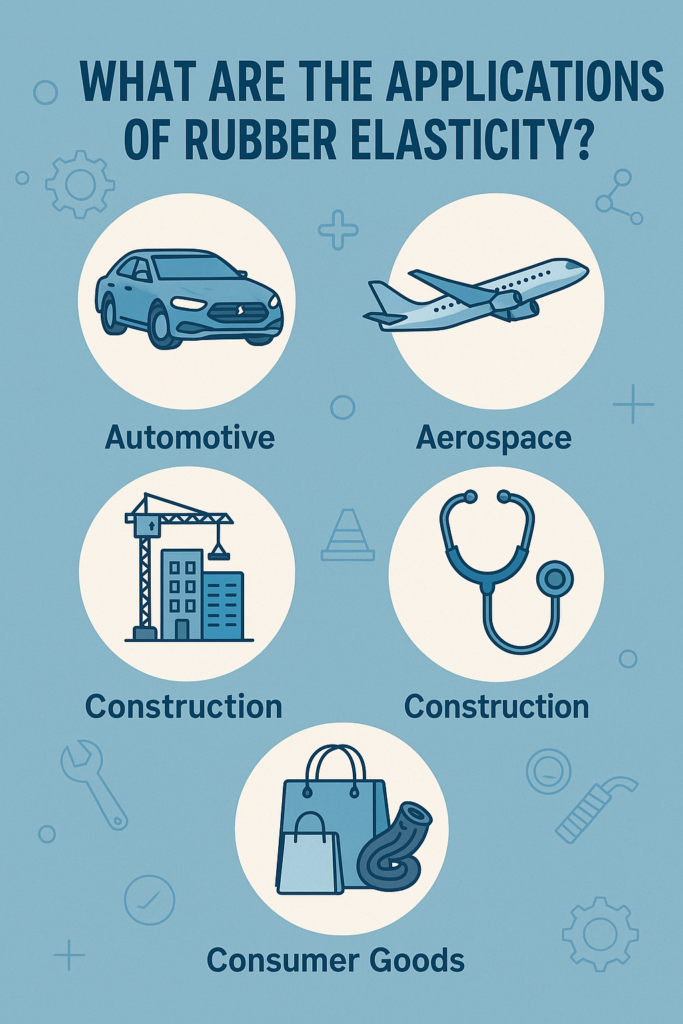
The applications of rubber elasticity are as follows:
Automotive
The automotive industry relies heavily on rubber elasticity for components that require flexibility, durability, and resilience. Automotive seals, shock absorbers, and vibration dampers benefit from rubber’s ability to deform under pressure and return to its original shape. Tires, a critical application of rubber elasticity, provide grip and impact resistance, ensuring safety and performance on the road.
Aerospace
In aerospace, rubber elasticity is important for components that must endure extreme temperature fluctuations and mechanical stress. Aerospace components such as sealing materials, fuel line hoses, and flexible connectors utilize high-performance elastomers to maintain structural integrity. Vibration isolation mounts and shock absorbers in aircraft also depend on rubber’s energy-absorbing properties to enhance flight safety and performance.
Medical
The medical industry uses rubber elasticity for various applications that require biocompatibility and durability. Medical tubing, surgical gloves, and flexible seals in diagnostic devices all depend on rubber’s ability to stretch and recover without compromising strength. The elasticity of rubber ensures that medical equipment remains functional under repetitive use while providing patient safety and comfort.
Construction
The construction industry benefits from rubber elasticity in sealing, insulation, and vibration absorption applications. Industrial gaskets, expansion joints, and flexible roofing membranes rely on rubber’s ability to withstand mechanical stress and environmental conditions. Sealing materials used in window and door frames ensure airtight insulation, improving building energy efficiency.
Consumer Goods
Rubber elasticity is required in various consumer goods, offering comfort, durability, and flexibility. Footwear soles, sports equipment, and household items such as rubber gloves and flexible connectors rely on rubber’s deformability and recovery. The elasticity of rubber enhances product longevity and user comfort, making it an integral material in everyday applications.
What are the Benefits of Rubber Elasticity?
The benefits of rubber elasticity are versatility, durability, resistance, insulating properties, shock absorption, and energy efficiency.

These characteristics make rubber an important material for a wide range of industrial and consumer applications. Rubber’s ability to stretch, deform, and recover allows it to be used in high-performance products, from automotive seals to vibration dampers, enhancing both functionality and longevity.
Versatility
Rubber elasticity offers high flexibility, allowing it to be molded and adapted for various applications, from industrial gaskets to footwear soles. This versatility makes rubber a preferred material for manufacturing products requiring resilience and adaptability in changing conditions.
Durability
With excellent wear durability and impact resistance, rubber maintains its integrity even under extreme mechanical stress. Automotive tires, for example, rely on rubber’s durability to withstand rough road conditions, ensuring long service life and performance reliability.
Resistance
Rubber compounds exhibit strong chemical resistance, waterproof properties, and heat tolerance, making them ideal for harsh environments. Industrial hoses used in the oil and gas industry benefit from rubber’s resistance to corrosive substances, ensuring safety and efficiency.
Insulating
Rubber’s low compression set and insulating properties make it a key electrical insulation and thermal protection material. Rubber insulation is commonly used in a variety of applications due to its ability to resist heat and electrical conductivity. For instance, electrical cables coated with rubber provide superior dielectric strength, preventing energy loss and enhancing safety in power distribution systems.
Shock Absorption
Rubber’s shock absorption and vibration damping capabilities make it necessary for reducing mechanical stress. Engine mounts in vehicles use rubber to absorb vibrations, preventing damage to surrounding components and improving overall driving comfort.
Energy Efficiency
Rubber elasticity contributes to improved energy efficiency in industrial applications by reducing energy loss through deformation mechanics. Sealing materials in HVAC systems, for example, helps maintain temperature control and reduce energy consumption in buildings.
Why Measuring Rubber Elasticity is Important?
Measuring rubber elasticity is important because it determines the material’s ability to stretch, recover, and perform under mechanical stress. Accurate measurement helps manufacturers ensure that rubber components meet the required tensile strength, flexibility, and durability for specific applications. For example, in automotive seals, precise elasticity testing ensures that the rubber maintains its shape and sealing properties under extreme temperature fluctuations and pressure variations. Rubber products fail prematurely without proper measurement, leading to performance issues and increased maintenance costs.
Why Does Rubber Have Elasticity?
Rubber has elasticity because of its unique polymeric structure, which consists of long, flexible molecular chains that stretch and return to their original shape. Weak intermolecular forces hold these polymer chains together, allowing movement when stress is applied. When the force is removed, the chains retract due to their natural entropy-driven tendency to return to a lower-energy state. Vulcanization enhances this property by introducing cross-links between the polymer chains, improving the material’s resilience, tensile strength, and long-term elasticity.
How Rubber Elasticity Influences Gasket Performance
Rubber elasticity enables a gasket to compress and recover its shape repeatedly without permanent deformation. This behavior is critical for maintaining a tight seal between surfaces, especially in environments with pressure or temperature fluctuations. A well-engineered rubber gasket relies on this elastic property to prevent leaks, absorb vibration, and extend service life.
What is the Value of Elasticity of Rubber?
The value of elasticity of rubber ranges between 1 and 10 MPa. It is measured using parameters such as modulus of elasticity, elongation at break, and tensile strength. The modulus of elasticity for natural rubber ranges between 1 to 5 MPa, while synthetic rubbers vary based on formulation and cross-linking density. Factors such as temperature, filler content, and vulcanization influence these values, affecting rubber’s ability to stretch and recover. Understanding these elasticity values is important for applications requiring precise mechanical performance, such as medical tubing, industrial gaskets, and shock absorbers.
Can Rubber Be Overcured?
Yes, rubber can be overcured, which negatively impacts its mechanical properties. Overcuring occurs when excessive heat or prolonged vulcanization introduces too many cross-links in the rubber matrix, making it brittle and reducing its flexibility. This leads to a loss of elasticity, lower tensile strength, and increased susceptibility to cracking. Overcured rubber products, such as seals and gaskets, fail under pressure, leading to leaks or mechanical breakdowns. Proper curing process control is important to maintaining the optimal balance between strength and flexibility in rubber products.
What are Elastomers?
Elastomers are a class of polymeric materials that exhibit rubber-like behavior, characterized by high elasticity and resilience. They consist of long-chain molecules stretching significantly under stress and returning to their original shape once the force is removed. Natural rubber, silicone rubber, nitrile rubber, and fluoroelastomers offer unique properties such as chemical resistance, thermal stability, and impact absorption. Elastomers are widely used in applications requiring flexibility and durability, including automotive components, medical devices, sealing materials, and industrial gaskets.
What Are Elastomers Examples?
The following are examples of elastomers:
- Natural Rubber (NR)
- Styrene-Butadiene Rubber (SBR)
- Nitrile Rubber (NBR)
- Silicone Rubber (VMQ)
- Fluoroelastomers (FKM)
- Ethylene Propylene Diene Monomer (EPDM)
- Polyurethane Rubber (PU)
What Are the Properties of Elastomers?
The following are the properties of elastomers:
- High elasticity
- Excellent flexibility
- Good tensile strength
- Resistance to abrasion
- Chemical resistance
- Thermal stability
- Low compression set
- Electrical insulating properties
- High impact resistance
- Weather resistance
What Are the Types of Elastomers?
The following are the types of elastomers:
- Natural Elastomers
- Synthetic Elastomers
- Thermoplastic Elastomers (TPE)
- High-Performance Elastomers
- Specialty Elastomers
What is the Difference Between Elastomer and Polymer?
The main difference between elastomers and polymers is that elastomers are a specific category of polymers that exhibit high elasticity, allowing them to stretch and return to their original shape. In contrast, polymers are a broader class of macromolecules composed of repeating units with various properties, including rigidity, flexibility, or elasticity, depending on their chemical structure and formulation.
The main differences between elastomers and polymers are as follows:
|
Aspect |
Elastomer |
Polymer |
|
Definition |
A subclass of polymers with elastic properties |
A macromolecule made of repeating units |
|
Elasticity |
Highly elastic, stretch and return to shape |
Rigid, flexible, or elastic |
|
Structure |
Amorphous structure with cross-linking |
Have crystalline, amorphous, or semi-crystalline structures |
|
Examples |
Natural rubber, silicone, EPDM |
Plastics, rubber, resins, fibers |
|
Applications |
Seals, gaskets, tires, medical tubing |
Packaging, construction, textiles, coatings |
Is Elastic Rubber and Elastomer the Same?
No, elastic rubber and elastomer are not exactly the same. Elastic rubber refers to a specific type of elastomer with high stretchability and recovery, whereas elastomers are a broader category of polymers that include various types of flexible materials. All elastic rubbers are elastomers, but not all elastomers are elastic rubbers.
Where to Get Elastic Rubber Products?
To get high-quality elastic rubber products, you source them from specialized rubber manufacturers and suppliers that offer customized solutions for industrial and commercial applications. Find premium elastic rubber products at RubberXpert for tailored solutions that meet your specific industry needs.

